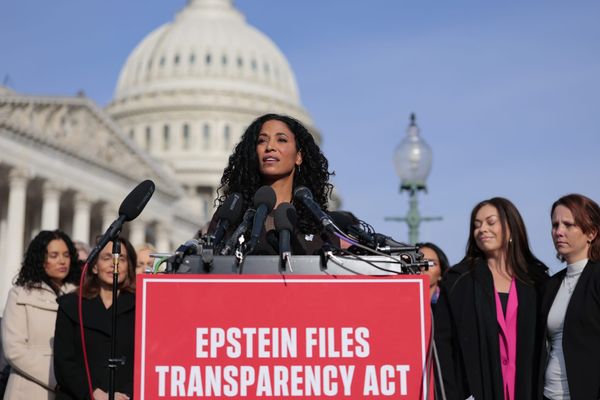ANALYSIS — Governors don’t get as much attention as members of Congress in a city dominated by federal politics. But gubernatorial races are having an impact on Washington as a growing number of lawmakers are leaving Capitol Hill to try to become the chief executive of their own states.
This is a huge cycle for governors, with New Jersey and Virginia hosting races this year and 36 states holding gubernatorial contests next year. Seventeen of those races don’t have incumbents, making it easier for aspiring politicos to run.
At this point, three senators and nine House members are running for governor, including Iowa Rep. Randy Feenstra, who has announced an exploratory bid. And there’s still time for that number to grow.
Early in the cycle, there was a chance that gubernatorial candidates could affect the fight for the House majority. But some of that risk has waned. If New York Rep. Mike Lawler had followed through on his run for governor, it would have been much harder for Republicans to hold his 17th District as an open seat. On the flip side, Maine’s 2nd District would have been difficult for Democrats to hold if Rep. Jared Golden had decided to run for statewide office.
The most competitive seat being left behind by a gubernatorial bid is Michigan’s 10th District, where GOP Rep. John James is running statewide for the third time. Trump won the seat with 52 percent of the vote in 2024, according to calculations by The Downballot, so the open seat in a midterm election could be problematic for Republicans.
The other House Republicans running for governor are leaving behind districts that Trump won by larger margins. The president took 56 percent in South Carolina Rep. Nancy Mace’s 1st District and at least 60 percent in the districts of Reps. Ralph Norman (South Carolina’s 5th), Andy Biggs (Arizona’s 5th), Byron Donalds (Florida’s 19th), John W. Rose (Tennessee’s 6th), Dusty Johnson (South Dakota’s At-Large) and Feenstra (Iowa’s 4th).
Rep. Mikie Sherrill of New Jersey is the only incumbent House Democrat running for governor, and she doesn’t even have to give up her seat because the race is taking place this year.
If Sherrill and Democratic former Rep. Abigail Spanberger of Virginia win their gubernatorial races in November, they would join a bipartisan group of current governors who have experience on Capitol Hill. Eleven incumbent governors previously served in Congress: Democrats Jared Polis (Colorado), Tim Walz (Minnesota), Michelle Lujan Grisham (New Mexico) and Kathy Hochul (New York) and Republicans Ron DeSantis (Florida), Mike Braun (Indiana), Jeff Landry (Louisiana), Greg Gianforte (Montana), Kelly Ayotte (New Hampshire), Kelly Armstrong (North Dakota) and Mike DeWine (Ohio).
On the Senate side, Democrat Michael Bennet of Colorado and Republicans Marsha Blackburn of Tennessee and Tommy Tuberville of Alabama are running for governor next year, although Bennet and Blackburn are not up for reelection this cycle and don’t have to give up their seats to run. But if they win, they’ll get to appoint their successors in the Senate. It would be the same situation for GOP Sen. Lisa Murkowski of Alaska, who could also run for governor. (Both Murkowski and Bennet first came to the Senate through appointments.)
The group of Republican lawmakers running for governor is expected to tick higher with Rep. Elise Stefanik’s anticipated challenge to Hochul in the Empire State. And still more GOP members are considering bids, including Reps. Tom Tiffany of Wisconsin, Dave Schweikert of Arizona and Harriet M. Hageman of Wyoming.
The lone Democrat in Congress who hasn’t ruled out a bid for governor is Sen. Alex Padilla of California. But a crop of former Democratic members are running or might run for governor this cycle.
Former Reps. Katie Porter and Xavier Becerra are already facing off in a crowded California primary; former New York Rep. Antonio Delgado (and incumbent lieutenant governor) is challenging Hochul for the Democratic nomination; and former Rep. Deb Haaland is running in New Mexico after a stint in the Biden administration.
Meanwhile, former Rep. Mary Peltola is expected to run for governor or the Senate in Alaska, and former Rep. Tim Ryan is a potential candidate in Ohio. Current Ohio Democrats Emilia Sykes and Greg Landsman could run for governor depending on the new congressional map drawn by Republicans, but statewide runs for them look less likely at this point.
Holding a majority of governorships doesn’t come with an extra prize, but Republicans currently have a 27 to 23 advantage nationwide. That could narrow to 26 Republicans and 24 Democrats if Democrats win in New Jersey and Virginia as expected later this year.
The post Running for governor continues to hold appeal on Capitol Hill appeared first on Roll Call.







